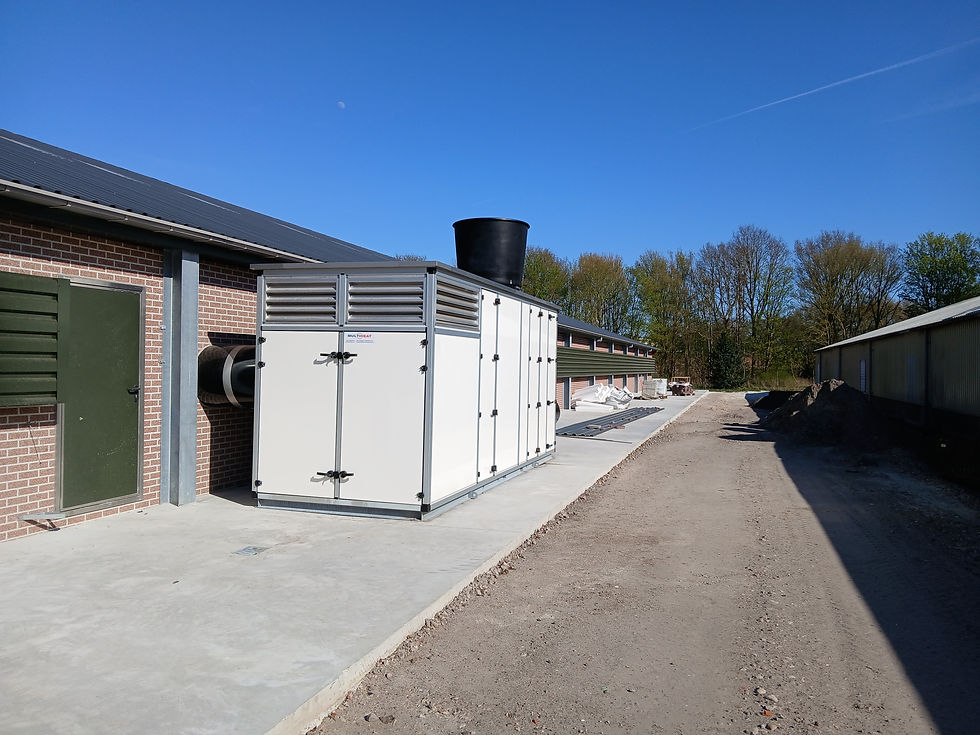
Low Carbon Technologies
Heat Recovery
Heat recovery is the process of capturing and reusing heat that would typically go to waste. It involves reclaiming a portion of the energy lost through heating and ventilation systems.
Heat Recovery Systems draw out stale air from inside a building, and feed it through a heat exchanger block while extracting heat from the stale air. Rather than losing this heat energy from the stale air to the outside, the system transfers it back into the building along with the filtered air coming in.
CFE is partnered with Multiheat International, leading producers of heat-recovery systems for poultry houses. The larger Heat X units offer a DRY heat recovery system with self-cleaning air filters, which don’t require continuous cleaning with water.
As the incoming shed air is filtered, high efficiency coated aluminium heat exchange blocks provide heat exchange without any dust build up.
An efficient heat recovery system encourages condensation to occur on the heat exchanger surface to capture the excess energy in the ‘phase change’ stage. Therefore clean condensate run off is encouraged in the design. The system does not require water cleaning therefore avoiding excessive water consumption and dirty water to be contained in tanks/lagoons.
The Multiheat X Changer offers a 50 - 65% saving on heating costs, while keeping an optimum inside climate for poultry.
The Multiheat X Changer is made up of three main parts:
-
Fans that move air in and out, variable speed to adjust to shed climate requirement
-
A compact high efficiency coated aluminium heat exchanger block
-
Air filtration and automated compressed air cleaning
Warm stale air from inside your poultry farm is pulled out by a fan and sent through the heat exchanger. At the same time, fresh cold air from outside is brought in through a separate path. These two airstreams pass by each other without mixing, and the warm indoor air transfers its heat to the cold outdoor air.
The fresh air, now warmed up, is then blown into your poultry farm by another fan. This air is clean and rich in oxygen, and replaces the old indoor air. When the amount of air coming in equals the amount going out, it's called "balanced ventilation."
There is also an optional preheating system available, which can be built into the unit. This can be useful for regions with severe winter conditions, as the system will preheat the fresh incoming air to keep the poultry farm at a level temperature.
For more information, please contact us via our online form.




How does the Multiheat X Changer work?

The Multiheat X Changer uses a cross-flow system. This means that warm house air (red) ➀ and external fresh air (blue) ➁ pass through the exchanger module ➂ at the same time, but without mixing. The filter module ➃ removes dust and other particles from the warm house air before it enters the heat exchanger. The filter modules are self-cleaning - compressed air is blown through the filters automatically when needed. The external fresh air is also filtered ➄ to ensure it is clean before entering the heat exchanger. The exchanger module is made of durable coated aluminium and is ammonia and CO2 resistant, and it can achieve an efficiency level of up to 85%. The warmed fresh air (orange) ➅, now clean and containing more oxygen, flows directly into the house, and the exhaust air (purple) ➆ exits to the outside via the exhaust chimney.








